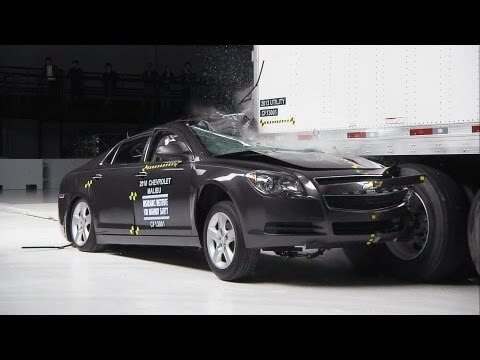 IIHS calls for tougher standards on trailer guards following recent under-guard crash testing.
IIHS calls for tougher standards on trailer guards following recent under-guard crash testing.
This week, the Insurance Institute for Highway Safety (IIHS) released the results of its trailer guard crash-testing. Research shows that trailer guards, when engineered and installed properly, can save lives, but the IIHS report shows that many trailer manufacturers fail to provide an adequate level of protection against under-ride crash fatalities.
According to the IIHS, the guards generally work well to prevent under-ride, except in off-center crashes- crashes on the edges of the trailer.
To see how well the latest guards performed, IIHS engineers used trailers from eight of the largest manufacturers and put them though progressively harder crashes. The first test was a straight -on crash, the second was a 50/50 and the third was a 30% overlap crash. All 8 trailers were equipped with under-ride guards that meet U.S. and Canadian safety standards.
The IIHA used a 2010 Top Safety Pick, Chevrolet Malibu in the crash testing. The truck was parked and the car was traveling at 35-40 mph.
Only one trailer passed all three tests. The under-ride guard on the Manac trailer was the only trailer that prevented underride in a 30 percent overlap crash.
What sets the Manac apart is its design. The supports of its under-ride guard are attached to a reinforced floor and spaced just 18 inches from the edge, not near the center like the other trailer’s under guards.
“Our tests suggest that meeting the stronger Canadian standard is a good first step, but Manac shows it’s possible to go much further,” says David Zuby, the Institute’s chief research officer.
“The crash tests show how this occurs. The 2010 Malibu was an IIHS TOP SAFETY PICK, and in the 40 mph moderate overlap barrier test used to evaluate the Malibu’s frontal crash-worthiness, measurements recorded by a dummy in the driver seat indicated serious injuries were unlikely. Similarly, in the under-ride tests in which the guards held up, the Malibu’s structure and airbags protected the dummy, and injury measures were generally low and not life-threatening. In contrast, when the guards failed, head and neck injury measures were so high that real drivers would have died,” the report states.
Statistics
In 2011, 260 of the 2,241 passenger vehicle occupants killed in large truck crashes died when the fronts of their vehicles struck the rears of trucks. That’s down from 460 out of 3,693 in 2004. The decline is likely due in part to changes in both truck and passenger vehicle traffic resulting from the weak economy.
A 2011 IIHS study of 115 crashes in which a passenger vehicle struck the back of a heavy truck or semitrailer found only about one-fifth involved no under ride or negligible under ride. Nearly half of the vehicles had severe or catastrophic under-ride damage, and those vehicles accounted for 23 of the 28 fatal crashes in the study.
| Crash test results for 8 top-selling trailers | |||
|---|---|---|---|
| Full-width | 50% overlap | 30% overlap | |
| Great Dane | pass | pass | fail |
| Hyundai | pass | pass | fail |
| Manac | pass | pass | pass |
| Stoughton | pass | pass | fail |
| Strick | pass | pass | fail |
| Utility | pass | pass | fail |
| Vanguard | pass | fail | n/a |
| Wabash | pass | pass | fail |
“If trailer manufacturers can make guards that do a better job of protecting passenger vehicle occupants while also promising lower repair costs for their customers, that’s a win-win,” Zuby says. “While we’re counting on NHTSA to come up with a more effective regulation, we hope that in the meantime trailer buyers take note of our findings and insist on stronger guards.”
